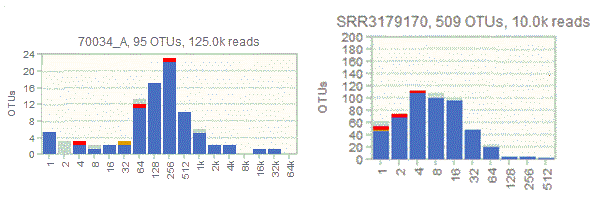Log-normal abundance distribution
See also
Octave plot
Interpreting octave plots
otutab_octave command
Considering the distribution of abundances or frequencies
of OTUs (or species) is a method for characterizing the
alpha diversity of a sample or community.
Usually, there are large numbers of low-abundance OTUs and few
high-abundance OTUs. See
Wikipedia
article on relative species abundance. The shape of the distribution can
be modeled mathematically. Proposed shapes include log-normal, Fisher's
log-series (different from log-normal), and geometric series.
In practice, abundance distributions observed in traditional
biodiversity studies are often approximately log-normal, meaning that if the
abundances are binned and plotted on a log-scale histogram then an
approximately normal (bell-shaped) curve is seen. This can be understood
theoretically by noting that if the abundance of an OTU is determined by
independent random variables, then as the number of parameters increases the
distribution will tend towards a Gaussian (this follows from the
central limit
theorem).
If all OTUs have been observed, and the distribution is
approximately log-normal, then a complete bell curve will be seen, as in the octave plot on the
left below. If sampling is incomplete, then the distribution is truncated so
that (conceptually) some of the distribution is to the left of the y
axis, representing OTUs which have not been observed (plot on right below).
An important advantage of octave plots is that they preserves the shape when
it is truncated due to incomplete sampling, which is not the case with the
binning in Preston's paper (1948) or textbooks such as Measuring
Biological Diversity (Magurran 2004).

If
part or all of the distribution appears to be approximately log-normal, this
suggests that these OTUs are participating in an interacting ecosystem.




